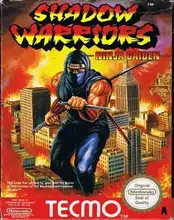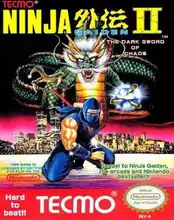Few games on the Nintendo Entertainment System burned themselves into the collective memory of gamers quite like Ninja Gaiden. It wasn't just another action-platformer; it was a masterclass in challenge, storytelling, and pure, unadulterated cool. For many of us who grew up with the grey box, the name Ryu Hayabusa conjures immediate memories of lightning-fast sword swings, gravity-defying wall jumps, and a level of difficulty that bordered on the absurd.
Released by Tecmo in the late 80s, Ninja Gaiden arrived during the golden age of 8-bit gaming and quickly set itself apart. It wasn't just the tight controls or the satisfying combat; it was the groundbreaking integration of cinematic cutscenes that told a surprisingly deep and engaging story for the era. This wasn't just jumping and stabbing; this was an experience.
The Legend of Ryu Hayabusa
The story of Ninja Gaiden kicks off with a classic revenge plot that quickly escalates into a globe-trotting adventure to save the world. You play as Ryu Hayabusa, a young ninja seeking vengeance for his father's apparent death. This quest leads him from the snowy mountains of America to the ancient ruins of the Amazon, crossing paths with mysterious figures, powerful demons, and a shadowy organization led by the villainous Jaquio.
What made the narrative stand out were the "Tecmo Theater" cutscenes. These weren't just static screens; they were dynamic, anime-inspired sequences with varying camera angles and expressions that brought the characters and plot to life. For an NES game, this was revolutionary and added a layer of immersion rarely seen before.
Gameplay: Sword Swings and Wall Jumps
At its core, Ninja Gaiden is a side-scrolling action-platformer. You guide Ryu through treacherous levels filled with enemies, traps, and challenging jumps. Ryu's primary weapon is his Dragon Sword, but he also has access to various Ninja Arts (sub-weapons) like the throwing stars, the useful jumping slash, and the devastating Fire Wheel.
Movement feels crisp, and the wall jump mechanic was particularly innovative, allowing Ryu to scale vertical shafts and reach hidden areas. Mastering the rhythm of combat, platforming, and sub-weapon usage is key to survival.
Tecmo Theater: More Than Just Pixels
While the gameplay was solid, the "Tecmo Theater" cutscenes were the true innovation. At a time when most game stories were relegated to a few lines of text or a static image, Ninja Gaiden delivered animated sequences that pushed the boundaries of what the NES could do.
These scenes provided context, developed characters, and built tension, making the player feel more invested in Ryu's journey. They were stylish, dramatic, and a huge part of the game's appeal, proving that video games could tell compelling stories.
The Infamous Difficulty: "Nintendo Hard" Defined
Let's not sugarcoat it: Ninja Gaiden is hard. Like, really, really hard. It's often cited as a prime example of "Nintendo Hard," a term used to describe games from that era known for their unforgiving challenge.
Enemies respawn instantly when you backtrack even slightly, often appearing in positions that make platforming frustrating. Later levels throw wave after wave of diverse foes at you, demanding pixel-perfect jumps and split-second reflexes. And then there are the bosses, which require learning precise patterns while dodging relentless attacks.
Perhaps the most notorious challenge is the final boss gauntlet. Lose to the final form of the final boss, and the game doesn't just send you back to the start of the fight; it sends you back to the beginning of the entire final act. This design choice, reportedly a glitch left in intentionally, has caused countless controllers to be thrown and shouts of frustration to echo through living rooms. Yet, overcoming these brutal challenges felt incredibly rewarding.
Legacy and Where to Play Today
Ninja Gaiden spawned several sequels and remains a beloved classic. Its influence can be seen in countless action games that followed.
If you want to experience this piece of gaming history today, you have options:
- Official Ports: The original NES version has been released on various platforms over the years, including the Virtual Console services on Wii, 3DS, and Wii U, and is currently available as part of the Nintendo Switch Online service.
- Compilations: It was included in the Ninja Gaiden Trilogy for the Super NES, which offered updated graphics and sound.
- Emulation: The original NES version and the PC Engine port (which had some graphical and audio differences) can be played via emulation, keeping the retro spirit alive for preservation purposes (e.g., check out resources like the Internet Archive's software library).
Why We Still Love It
Despite the rage-inducing difficulty, retro gamers hold a special place in the hearts of Ninja Gaiden. It was a game that demanded skill, patience, and perseverance. It delivered a compelling story through innovative cutscenes and featured some of the coolest ninja action on the NES.
It's a game that tested your limits, but the sweet taste of victory after finally conquering a seemingly impossible section was unmatched. Ninja Gaiden wasn't just a game; it was a rite of passage for a generation of gamers.
Frequently Asked Questions
Is Ninja Gaiden on the NES really that hard? Yes, it is notoriously difficult, often cited as one of the hardest games on the NES due to relentless enemies, challenging platforming, and punishing boss encounters.
What are the "Tecmo Theater" cutscenes? These were revolutionary anime-style cinematic sequences used between gameplay sections to tell the game's story, adding depth and immersion not commonly found in NES games.
Who is the main character? You play as Ryu Hayabusa, a ninja on a quest for revenge that turns into a mission to save the world.


